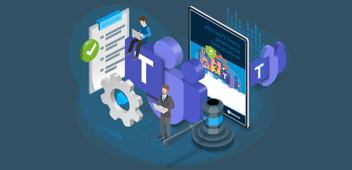Microsoft Teams has become central to how organizations communicate and collaborate. As of early 2024, Microsoft reports over 320 million monthly active users worldwide. Every day, teams across departments, geographies, and time zones rely on it as their single hub for chat, meetings, file sharing, and app integration.
Yet with that growth comes complexity. As Teams usage multiplies, unmanaged environments tend to spawn chaos: redundant teams, inconsistent naming, unchecked guest access, and data sprawl. Without a solid governance framework, the risks of security incidents, compliance failures, and productivity loss grow with every new channel.
In this guide, you'll find a structured set of Microsoft Teams governance best practices and a practical checklist to help your organization stay organized and secure as Teams usage grows..
In a nutshell: What is Microsoft Teams governance?

Microsoft Teams governance is the strategic framework of policies, roles, processes, and tools you implement to control and manage how your organization uses Teams. It's about finding the right balance between empowering users and protecting the organization's data.
A solid Microsoft Teams governance plan ensures that Teams is used consistently, securely, and efficiently. It helps your organization maximize the platform’s value while minimizing risks such as data sprawl, security breaches, and compliance violations.
Why Teams governance matters now
The need for Microsoft Teams governance is more urgent today than ever before. As organizations accumulate more content, files, guest users, and collaboration channels, the risk of data leakage, compliance violations, and “orphaned” digital assets multiplies.
What is more, the rise of AI tools like Microsoft Copilot has raised the stakes. Copilot’s ability to discover and synthesize information is only as good as the content it works on. If your Teams environment is riddled with duplication, stale data, or inconsistent labeling, Copilot may deliver inaccurate or misleading insights. It may even unintentionally expose sensitive information.
Effective Microsoft Teams information governance ensures that your Teams environment remains clean, discoverable, and reliable. With the right foundation, you can leverage AI confidently without worrying about unintended consequences.
Common mistakes and issues in Microsoft Teams governance
Before building a strong Teams governance plan, it's crucial to understand the common pitfalls. Many organizations we work with face similar challenges, often stemming from an initial lack of planning during a rapid Microsoft Teams implementation. Do any of these points sound familiar?
Lack of policies controlling team creation
This is the ultimate mistake that seeds chaos. Without a clear process for creating new teams, you get an uncontrolled explosion of unnecessary or duplicate teams, test teams, and channels for short-term projects that are never deleted. This teams sprawl makes it nearly impossible for users to find relevant information and for IT to manage the environment effectively.
No or inconsistent naming conventions
When a team can be named anything from "Project X" to "Marketing_Team_2025_Final_v2," the result is confusion. Inconsistent naming conventions make search and discovery a nightmare. You can't easily identify a team's purpose, department, or geographic location. This disorganization directly impacts data discovery tools and hinders the ability to apply targeted policies for security and retention.
Overly permissive guest access settings
Collaboration shouldn't stop at your company's walls, but uncontrolled external access is a major security vulnerability. Allowing any user to invite external guests without oversight can lead to extensive and untracked sharing of sensitive internal data. This poses a significant risk of data leakage and can lead to serious breaches of regulations like GDPR.
Missing or incorrect sensitivity labels
Microsoft 365 provides powerful tools like Sensitivity Labels to classify and protect your data. Not using them is like leaving the vault door open. Without labels, your organization has no way to distinguish between public announcements and highly confidential intellectual property. This means critical information isn't properly encrypted or protected by access restrictions, making it vulnerable to both internal and external threats.
Only one owner to a team or channel
A team with a single owner is a ticking time bomb. What happens when that owner leaves the organization or changes roles? The team becomes "orphaned", a digital ghost ship with no one at the helm. This content is unmanaged, unmonitored, and will never be archived or deleted, creating a repository of stale, potentially risky information that clutters your tenant and misleads AI tools.
No lifecycle policies for inactive teams
Teams are created for projects, events, and initiatives, many of which have a finite lifespan. Without lifecycle management, these teams persist indefinitely after they've served their purpose. This digital clutter of outdated teams consumes valuable storage, increases security risks, and pollutes search results with outdated information, severely degrading the accuracy of AI outputs from tools like Copilot.
Poor documentation of compliance processes
If your governance processes live only in the head of a single administrator, you have a single point of failure. Without clear documentation, you cannot demonstrate compliance during an audit, onboard new team members effectively, or scale your governance efforts as the organization grows.
Manual governance without automation
Relying on IT administrators to manually check every setting, review every guest, and clean up every inactive team is simply unsustainable. Manual governance is slow, prone to human error, and creates a significant bottleneck for your organization. It cannot scale to meet the demands of a dynamic digital workplace, leaving you perpetually one step behind the risks.
Practical checklist for Microsoft Teams governance and compliance
Ready to move from chaos to control? This practical checklist breaks down the essential components for managing Microsoft Teams effectively and building a robust governance strategy. Use these points as a guide to build a framework that works for your organization.
1. Control team creation to prevent sprawl
Uncontrolled team creation is one of the biggest sources of chaos in Microsoft Teams. Preventing sprawl starts with structured provisioning and naming.
How to do it:
- Implement a Team provisioning process where users request new teams via a form that captures purpose, owners, and expected lifespan.
- Enforce consistent naming conventions automatically based on attributes like department, project, or region (e.g., “PROJ-Marketing-Europe”).
- Use team templates to predefine channels, tabs, and settings for common scenarios, ensuring consistency from the start.

2. Manage team lifecycles automatically
Every team has a natural beginning, middle, and end. With clear Microsoft Teams lifecycle management and policies in place, you can keep your Microsoft Teams environment organized, relevant, and secure by ensuring each team follows a defined path from creation to archival or deletion.
How to do it:
- Set expiration policies to flag inactive teams for review after a defined period (e.g., 180 days).
- Define a clear archival process and use automation to archive teams that are no longer active but must be retained for records.
- Automate the deletion of obsolete teams once they are confirmed unnecessary, freeing up storage and keeping data current.
3. Ensure every team has at least two owners
Assigning at least two owners to every team ensures continuity, accountability, and proper management of content, even when roles or personnel change.
How to do it:
- Require at least two owners per team or channel.
- Automate owner verification checks to identify and correct teams with only one or no active owner.
- Define ownership transfer workflows for teams whose owners are deactivated or depart the organization.
- Encourage group owners to share responsibility for maintaining membership accuracy, permissions, and compliance.

4. Strengthen data security with a shared responsibility approach
Microsoft Teams operates under a shared responsibility model. Microsoft secures the cloud infrastructure, while your organization is responsible for securing how Teams is configured and used. This includes access controls, permissions, and data protection.
Microsoft provides extensive documentation on its security practices through the Microsoft 365 security guide. You can build on this foundation by applying your own data governance and security measures to protect identities, devices, and data.
How to do it:
- Limit user access and permissions so employees can only access the data they need.
- Regularly audit security settings to detect gaps or overexposed content.
- Use Sensitivity Labels (see next section) to classify and protect confidential information automatically.
5. Classify and protect data with Sensitivity Labels
Data classification is the cornerstone of modern Microsoft Teams information governance. Sensitivity Labels in Microsoft 365 ensures that access, encryption, and sharing policies follow your data wherever it goes.
How to do it:
- Define a clear classification schema (e.g., Public, Internal, Confidential, Highly Confidential).
- Apply security labels to Teams containers to control guest access, external sharing, and unmanaged device access.
- Use labels to automatically apply client-side protections such as encryption, watermarking, and restricted access.
- Continuously review label usage to ensure consistency across Teams, SharePoint, and Microsoft 365 Groups.
6. Use Microsoft Purview to enforce compliance and retention
Microsoft Purview (formerly Compliance Center) provides the centralized tools to monitor and enforce your compliance requirements. Within Purview, Compliance Manager offers a dashboard that helps you assess and track your organization’s compliance posture over time.
How to do it:
- Configure Data Loss Prevention (DLP) policies to prevent accidental sharing of sensitive information in Teams chats and channels.
- Set up retention policies to ensure data is retained or deleted according to your legal or business requirements.
- Use Compliance Manager to track improvement actions and measure progress toward compliance frameworks.
- Review audit logs and alerts regularly to stay on top of security and compliance activity across Teams.
Please note: Microsoft’s Compliance Manager alone is not enough to achieve your desired compliance status, but it’s an excellent starting point for understanding your current position and measuring progress in your Microsoft Teams compliance journey.
7. Govern external and guest access
Collaboration with external users is essential for modern work. With the right controls in place, you can enable seamless, secure collaboration while protecting your organization’s data.
How to do it:
- Restrict who can invite guests, limiting it to approved users or security groups.
- Configure guest permissions to restrict actions of external users (e.g., no sharing files or adding members).
- Implement regular, automated access reviews, prompting owners to re-certify guest access.
- Maintain visibility into guest activity with regular monitoring to prevent unauthorized data sharing.

8. Secure shared channels with Microsoft Teams Connect
Microsoft Teams Connect enables collaboration across organizations through shared channels. It’s powerful, but requires careful governance.
How to do it:
- Define policies for external collaboration, specifying which partner organizations are allowed.
- Use Microsoft Entra ID cross-tenant access policies to control inbound and outbound sharing.
- Review shared channel relationships regularly to confirm they remain necessary and compliant.
- Document how shared channels are governed to ensure external collaboration remains secure and transparent.
9. Document and communicate your governance policies
Governance isn’t effective if it only exists in the minds of administrators. Documentation provides continuity, clarity, and transparency.
How to do it:
- Create a governance policy document outlining naming conventions, lifecycle rules, and ownership requirements.
- Store it in a central location accessible to IT, compliance, and business teams.
- Update documentation regularly and communicate policy changes proactively to end users.
10. Build a cross-functional governance committee
Microsoft Teams governance is not just an IT project; it’s an organizational initiative that spans departments.
How to do it:
- Form a governance committee including IT, Security, Legal/Compliance, HR, and business unit leaders.
- Meet regularly to review adoption metrics, risks, and policy effectiveness.
- Use the group to align governance with real-world use cases and ensure policies are practical and business-friendly.
11. Educate and empower your users
Governance succeeds when users understand why it matters. The goal is to make them partners in security and compliance.
How to do it:
- Create a central resource hub for Teams users (for example, a SharePoint site or dedicated team) containing training materials, FAQs, and request links.
- Offer short learning modules on topics like external sharing or sensitivity labels.
- Recognize and reward “governance champions” within departments who promote best practices.
12. Automate policy enforcement
Manual policy checks don’t scale. Automation ensures that governance is continuous, consistent, and auditable.
How to do it:
- Deploy an automated policy engine to detect violations (e.g., teams without owners or with unauthorized guest access).
- Automate alerts and remediation workflows, reducing manual effort and ensuring timely corrections.
- Use automation to enforce naming, sensitivity, and lifecycle policies without human intervention.
13. Automate data collection and reporting
Visibility is the foundation of good governance. Automated data collection ensures you always have an accurate, real-time view of your environment.
How to do it:
- Implement tools that inventory all teams, members, guests, and connected apps automatically.
- Use dashboards to visualize compliance, adoption, and risk trends.
- Automate report generation for audits and license management to save time and eliminate manual errors.
14. Automate remediation for faster risk resolution
True governance automation doesn’t stop at detection. It takes action. Automated remediation ensures that identified issues are resolved quickly and consistently, without waiting for manual intervention. This minimizes risk exposure and keeps your Microsoft Teams environment continuously compliant.
How to do it:
- Set up automated workflows that immediately act on policy violations, such as archiving inactive teams, fixing naming convention errors, or reapplying missing sensitivity labels.
- Use predefined rules to trigger remediation processes the moment a governance issue is detected.
- Configure notifications for IT administrators when an automated fix requires review or escalation.
- Log every automated action to maintain compliance traceability and simplify audit preparation.
15. Share governance responsibility with end users
Governance works best when it’s shared. Instead of making IT the bottleneck for every access review or compliance check, empower users to take ownership of their digital spaces. This approach strengthens accountability, boosts adoption, and dramatically reduces administrative overhead.
How to do it:
- Embed governance awareness directly in Teams, where users already collaborate.
- Give team owners responsibility for periodic guest access reviews, content cleanup, or policy confirmations.
- Use in-app guidance and notifications to make these actions simple and context-driven, for example, approving or denying guest access with one click.
- Track all user actions automatically to maintain audit trails and accountability while freeing IT for more strategic work.
16. Simplify and accelerate governance with third-party automation
While Microsoft offers strong native controls, managing them across multiple admin centers can be complex. Third-party apps streamline governance and enhance automation.
How to do it:
- Use specialized Microsoft Teams governance software like Rencore Governance to centralize, automate, and scale policy management.
- Leverage pre-built templates and dashboards to achieve time-to-value in days, not months.
- Gain holistic visibility across Teams, the Power Platform, and Copilot readiness from a single interface.
- Free IT from repetitive tasks with automated remediation and delegated actions.

17. Treat governance as an ongoing strategy
Effective governance is a continuous cycle of monitoring, adjusting, and improving. Keep your Microsoft Teams governance strategy up to date and adapt it to changing requirements.
How to do it:
- Review and update Microsoft Teams governance policies regularly to reflect organizational and technological changes.
- Track metrics such as team creation rates, guest access activity, and policy compliance over time.
- Align governance evolution with broader AI governance and readiness initiatives to ensure your environment supports secure, intelligent collaboration.
Conclusion: Your 3-step plan for smarter Microsoft Teams governance
Avoiding common Microsoft Teams governance pitfalls starts with clarity and simplicity. The goal isn’t to add layers of control but to build a framework of automation and shared responsibility that keeps collaboration secure and efficient.
1. Establish the right foundations
Start by putting control mechanisms in place: define who can create teams, apply consistent naming conventions, and ensure every team has at least two owners. Then, reduce sprawl and security risks with lifecycle policies, guest access reviews, and sensitivity labels that classify and protect your data.
2. Move from manual oversight to automation
Manual checks can’t keep pace with today’s dynamic environments. Instead, use intelligent policy engines and dynamic dashboards to enforce rules, detect violations, and fix them automatically before they cause risk. Combine this with user enablement, empowering employees to take action directly in Teams through in-app prompts and delegated tasks.
3. Empower Teams with Rencore Governance
Managing Microsoft Teams governance through Microsoft’s native tools often means juggling multiple dashboards and complex configurations. Rencore Governance eliminates that complexity. It provides a unified, purpose-built platform for Microsoft 365 and Teams that helps you:
- Automate policy enforcement and lifecycle management across Teams, SharePoint, OneDrive, and the Power Platform.
- Gain 360° visibility into your entire tenant, with real-time dashboards for compliance, usage, and risk.
- Remediate issues automatically through configurable workflows and instant reporting.
- Empower your users with the Rencore end-user app, bringing governance tasks directly into the Teams interface where collaboration happens.
- Stay audit-ready with comprehensive traceability and GDPR-grade compliance controls.
Ready to experience how easy, automated, and collaborative Microsoft Teams governance can be?
Explore Rencore Governance today and take the first step toward complete control and confident compliance.
Or dive deeper into your strategy with our free “Microsoft Teams governance best practices” whitepaper, the essential guide to choosing the right approach for your organization.




